Dayens Ecstasy IV SE Power Amplifier

 Everyone’s got a signature piece. For future president Dwayne “The Rock” Johnson, it’s his right eyebrow. For Leonardo (the historical one), it’s the Mona Lisa. And for Warhol, it was… soup cans; specifically, 32 paintings of Campbell’s soup cans neatly arrayed. Oh, and Brillo boxes. Let us not forget Brillo.
Everyone’s got a signature piece. For future president Dwayne “The Rock” Johnson, it’s his right eyebrow. For Leonardo (the historical one), it’s the Mona Lisa. And for Warhol, it was… soup cans; specifically, 32 paintings of Campbell’s soup cans neatly arrayed. Oh, and Brillo boxes. Let us not forget Brillo.

It’s a “clean” look, no?
For Zoran Dobrin, un-elected supreme leader of Serbian audio shop, Dayens, it’s the Ampino. Rumored to have been designed for a family member’s personal use while away at school, like a big rectangular blunt, it later got passed around to friends of said family member and went viral from there. Of course, this could be fake news but it sounds good and that’s good enough for me.
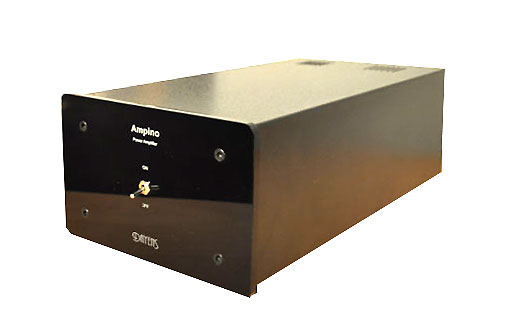
Zoran’s Ampino. Ahhhhh a masterpiece at last!
In any case, it’s virality was justified. This super-reliable, quiet little 35-watter, kicks like a proverbial (or literal) mule and sings like a pseudo-tube siren. Its parts are few and far between and what there is is overbuilt, over-spec’d and generally of the bespoke and holier-than-thou variety (i.e. Mundorf, Versace, Armani etc.). Equipped thusly, the li’l Ampino became the workhorse for many systems whose owners aimed high but paid low. Majoring on bass punch and dynamism, it’s only “failings” are really those of omission; chiefly of the finest details and the highest highs.
Indeed, an Ampino has served yeoman’s duty in my own system for the past six or so years and I know it’s sweet song well. Whenever I get a new amplifier in for a listen, I often cleanse my aural palate with a bit of a listen to the Ampino so I come to the new amp with a fresh notion of just how good audio can get for well under a grand. Then I see if the newcomer can justify many multiples of the Ampino’s street price. Sometimes it can’t.
So when he’s not maintaining his exceptional physique via his patented Dayens Workout Method (DWM) what can Zoran D. of Dayens do with more parts and more power?
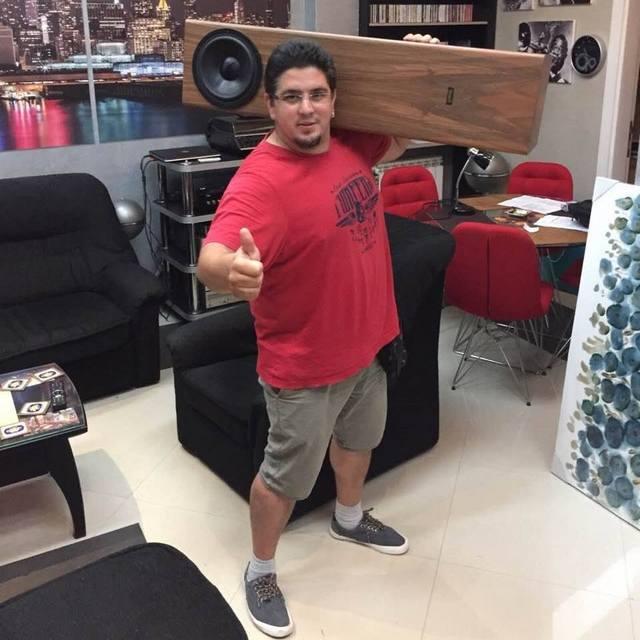
For more intense workout, add subwoofer
Le Poeme de L’exstase
I prefer Gestalt psychotherapy to psychoanalysis and I prefer what I’ll call more “gestalt” amplifiers to more “explicit” amplifiers. The latter sounds dirty and suggestive, though, really, they’re on the “clean” side; luridly detailed and tonally lighter by comparison. The latter are also the kind of amps that get called “accurate” or “true to source” a lot. That may be, but I never seem to enjoy my music as much through these squeaky-clean freaks. Digital equipment can be guilty of too much cleanliness for my taste as well, and while I’d never name names, my own experience with the original Chord Hugo comes to mind. I had to have one because everyone else had to have one, and then I sold the one I had; all in the span of like two weeks.
Clean ‘n clear? Check. A window on the very soul? Check. Enjoyable and emotionally engaging for hours on end? No checks. Those that prize detail and clarity in their playback to the exclusion of all else will no doubt completely disagree and are presently leering at me from behind the shopworn mint green casings of their collective oscilloscopes.
No matter. Leer, you engineers, leer! It’s why I prefer my Aqua R2R DAC so far to all comers; there’s a touch of warmth and humanity in the sound and somehow a bit more abstraction and mystery. The Dayens Ecstasy IV SE, a murdered-out (that’s hep cat slang for “all black”) 175 watt per channel (into 8 Ohms) dual mono power amplifier under review here, is in league with the abstract and human.
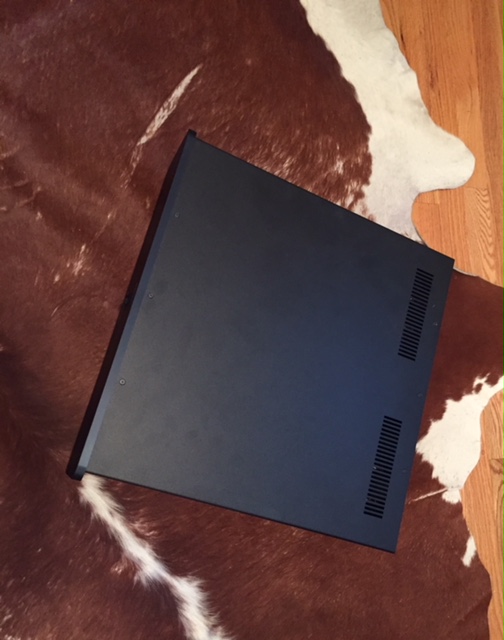
I call it “Ecstasy on Cowhide”
Potential energy
Do NOT listen seriously to the Dayens Ecstasy for the first 10 or 15 minutes after you turn it on. Similarly, after you power down, do not go about disconnecting wires from it to switch to another amp for at least 10 minutes. You have been warned. I wasn’t. The Ecstasy stores massive amounts of charge in its capacitors and takes a bit of runway to get up to full steam. On the plus side, it’ll also keep playing music happily for a while after you turn it off. That’s handy if your power goes out in a hurricane and you break the crank off your hand-cranked radio. Climate change is probably just temporary though, right?
Once up to speed, in the early going, connected to my tubed Modwright SWL 9.0 SE Anniversary preamp and Aqua La Voce DAC, the Dayens began to show me its cards. “Okay”, I thought; “sounding good, but sounding good in very much the same areas my Bel Canto Ref150S sounds good.” This is not good.
Too close for comfort! At times, I switched back and forth between the two amps every half hour or so doing relatively unscientific level-matched comparisons with my iphone’s DB meter app over various and sundry musical fare from Bat for Lashes to Prokofiev violin sonatas (Polychrome with Violinist Tobias Feldman via Tidal; meditative and austere stuff!)
More specifically, In terms of their sonics, this direct comparison with my recent “reference” amp, the diminutive cool-running ICEpower Bel Canto Ref150S (aka my “summer” amp), showed me both amps skewed slightly warm, both had ample power for my modest listening levels and listening space, both had excellent but not necessarily subterranean bass, both were suitably rhythmic, and both had excellent (though not wall-climbing) soundstage depth and width.
I felt my aural powers fading and thought “it has finally happened; the worst thing we audiophiles can have.” No; not a significant other banning the purchase of more audio equipment or a new kitten scratching the hell out of expensive speaker grilles. Worse. Gentleman (and lady), what we had here was for all the world an even match; audio equanimity. Negligible differences!!
Could it be? Hasn’t been the case for me in probably ten or more years of reviewing and listening to gear. I mean, things have sounded similar, but not the same. And to wit, one competitor was much more powerful on paper than the other (175 watts a side into 8 Ohms vs. 75). One was Class D and the other AB. One fit neatly into my stereo cabinet and the other didn’t. One was… okay both had black cases.
Now before we venture further and try and resolve this cliffhanger, allow me to be helpful for a change and put the tonality of the Dayens amp (really all three of the Dayens amps I’ve heard thus far including their excellent integrated) in perspective by way of comparison with other amps I’ve owned/auditioned at length.
In the thoroughly warm and well-heated far left corner, we have the class A Pass Labs F6. My long ago departed (sold not dead) Pass Aleph 3 hangs out in this well-warmed zone as well. In the far right corner, we have the Stello S100 Mk. II, Atsah Hypex-based monos and the Job 225. Those three are definitely tonally cooler customers than the Dayens.
The Wells Majestic integrated, Dayens Ecstasy and Ampino, and my summer ‘reference’ amp, the ICEpowered Bel Canto Ref150S, all hang out somewhere in the middle; the green zone. (Yes, it amuses me too that an amplifier called “ICEpower” is actually sonically on the slightly warm and toasty sideJ
Indeed, Bel Canto Ref150S and the Dayens Ecstasy under review were actually strikingly similar tonally; neither too warm or too cool though perhaps both just slightly toward the warm side of the pillow.
Venturing further…
So that’s it then? A friggin’ tie? We were lied to; told there’d be differences!! Okay I hear ya and we cant have that. So about a month into the review period, for your sake and for God, for Country and for Yale, I put on my pajamas in the middle of the day (fortunately I was off that day) and got intense. Not quite NAVY SEAL intense, but Army-desk-job-in-requisitions intense. Yes sir, when I put on pajamas the middle of a day shit’s about to get real!
I undertook a six or seven-hour half-marathon listening session with revealing material; I’m talkin’ superbly recorded solo piano and exquisitely played and recorded Mozart as well as some bass-laden indie pieces and some ol’ standby Bill Evans jazz. Okay so I’m not exactly bringing the musical hardcore, but I must’ve swapped back ‘n forth between the two amps with the same musical fare some 15 or 20 times.
But not only that. In the course of doing so, I also brought out my super-secret weapon; NO not a knit blue binky made by my grandma-ma (which I still have), but a Benchmark HGC DAC 3 I’ve been auditioning. This gives us a built-in solid-state preamp that’s a bit quieter than my Modwright (nearly zero self-noise) allied to a superb and perhaps very slightly more revealing DAC than my Aqua, (though I’ll admit the DAC in the Benchmark also sounded pretty friggin’ similar to my Aqua; maybe I’m losing it or more likely, never had it to begin with?).
Okay, now we’re “tawkin.” With the Benchmark DAC 3 in the picture as pre and DAC, More sonic differences began to emerge. Once heard, these differences were easier to spot for me with either preamp or DAC throughout the rest of the several months the Dayens amp was in my possession.
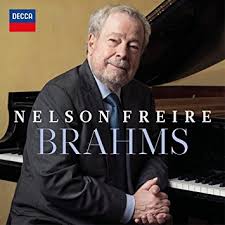 One of the recordings I “spun” during the pajama session was Nelson Freire’s (relatively) new recording of Brahms piano Sonatas on Decca and here the Dayens clearly had more tonal density; more sonic meat on the bone. Through it, Freire’s artfully recorded piano was slightly more corporeal and the dynamic swings were more apparent. Additionally, I experienced an effect which I hadn’t since I heard the lovely Wells Majestic integrated; namely, electrical silence.
One of the recordings I “spun” during the pajama session was Nelson Freire’s (relatively) new recording of Brahms piano Sonatas on Decca and here the Dayens clearly had more tonal density; more sonic meat on the bone. Through it, Freire’s artfully recorded piano was slightly more corporeal and the dynamic swings were more apparent. Additionally, I experienced an effect which I hadn’t since I heard the lovely Wells Majestic integrated; namely, electrical silence.
Sure, with the Dayens/Benchmark pairing (as with the Wells Majestic), you could put your ear to my 96db efficient Tekton Lore Reference speakers and you’d hear… almost nothing. Maybe the faintest hint of electronic hum or hiss. But with solo piano recordings like the Freire, this combo to a greater extent than the Bel Canto/Benchmark pairing, was infused with this sense of “electrical quietude” or what some might call a “black background”; more of the feeling that the instrument was there on a stage surrounded by blackness until a key was struck, and when the last echo of a key stroke had died away, it fell utterly silent; fell into blackness. Prior to that silence, the Dayens also dealt with these reverb trails in what I felt was a more “natural manner.” Read: they sounded maybe less like striking a key on a good synthesizer and letting the sound die away vs. the same key strike on a living breathing steel and wood piano.
The differences here were slight and might be missed in a quick back and forth (and were!), but came to be noticeable the longer I had the Dayens in the system. Yes! The Dayens liked the Benchmark preamp a lot and more so than my Bel Canto did, which seemed to sound more its natural self with the Modwright pairing. Even still, once heard, the subtle musical differences between the two amps remained apparent via either.
Additionally, there was something slightly more “ghostlike” and just a hair more artificial or “produced” about the sound of the Bel Canto, even when going all balanced by using its XLR inputs fed from the Benchmark’s XLR pre outs via a meter of Mogami Gold balanced interconnects. Scott LaFaro’s bass on “Sunday at the Village Vanguard” had a bit more depth and impact via the Dayens and this could be down to the power differential between the two amps, but it also had a slightly “woodier” and more natural string pop and sustain with the Dayens. Again, there was the slightly more natural reverb/decay of Evans’ notes; particularly evident in the treble range. Both amps produced roughly the soundstage width one is accustomed to on this recording with good equipment and neither was the equal of, say, the Atsah Hypex mono amps in stage width. The Dayens also evidenced slightly more stage depth than the Bel Canto.
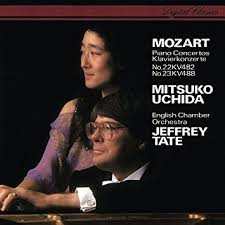 One of my favorite recordings of Mozart’s piano concerto No. 5 is Mitsuko Uchida’s 2006 Philips release with the English Chamber Orchestra and Jeffrey Tate conducting. She plays this rep with a kind of elegance, touch and vigor which would be almost singular in the modern age, save for Murray Perahia. To me, we are far here from some of the excesses of certain more “modern” and flashily dressed flamboyant so-called “super virtuosos.” Rather, we are in the realm of the exuberant, expressive and individual; but tasteful. That’s no easy feat.
One of my favorite recordings of Mozart’s piano concerto No. 5 is Mitsuko Uchida’s 2006 Philips release with the English Chamber Orchestra and Jeffrey Tate conducting. She plays this rep with a kind of elegance, touch and vigor which would be almost singular in the modern age, save for Murray Perahia. To me, we are far here from some of the excesses of certain more “modern” and flashily dressed flamboyant so-called “super virtuosos.” Rather, we are in the realm of the exuberant, expressive and individual; but tasteful. That’s no easy feat.
The recording of the No. 5 from the Tate set is sparkling and via the Benchmark/Dayens pairing, string tone glows and you can really perceive at times the felted piano hammer on string effect just prior to the resultant singing tone. The stage is broad and most importantly, Uchida through the Dayens makes you smile. There is nothing missing. You don’t wish for more this or less that. Moreover, the recording sounds suitably less reproduced and more actual.
Again, the Dayens/Benchmark combo plays with a very slightly less artificial and steely string tone than the Bel Canto/Benchmark pairing and remains electrically somehow quieter and slightly more dynamic.
As compared with it’s cheaper though more ubiquitous and esteemed stable mate, the Ampino, The Ecstasy is clearly from the same bloodline, but with the bigger amp there is even more detail and dynamism on tap and particularly evident is the more fully fleshed out top end. Less omission; same core musicality.
“He seems to spend his life appreciating subtle differences between things no one else cares about.”– Brother of my ex-girlfriend at a dinner party
This was a direct quote from my ex-girlfriend’s brother, now an award-winning author. The man had a way with words. At my expense. Of course, he was absolutely correct. How much better is this cup of espresso than that one? This glass of scotch than that one? This concert pianist than that one playing the same exact piece?
Our pursuits in audio are largely about subtlety. After all, I read somewhere recently that a large-scale marketing survey determined sound quality was the LEAST important factor in why people chose the particular set of headphones they did. That one shocked me but it shouldn’t have. Now these people were not “audiophiles” per se, and good for them. Caring dearly about what comprises your stereo system and how exactly it makes music is a niche endeavor which positively relies on your appreciation for subtle differences that yes, no one else cares about. Hell, OWNING a stereo system at all these days is a niche endeavor. That’s what an iPhone is for!
In sum, I suppose I could say that rather than a love song to yet another quietly reliable and eminently musical amp from Dayens, this review could also be perceived as laudatory to the Bel Canto amp, as it means that a tiny, cool-running and half as powerful amplifier utilizing ICEpower technology is almost giving the big boys in the room a musical run for the money.
However, in our land of scotch and subtlety, almost as musical is not “as musical.” Extended listening over several months, and not just in my pajamas, led me to the conclusion that the Dayens was the more impactful, tonally pure and engagingly soulful of the two amplifiers and paired with something like the one-box solution Benchmark HGC DAC 3, runs the Wells Audio Majestic very closely for my favorite music making system of the past few years.
How closely? Well, due to measures beyond my control (I literally couldn’t fit it in my cabinet), I no longer have the Wells in my possession so I’m not certain; but I can tell you from memory there are subtle differences between the twoJ
Ah, but the Dayens is an amp and the Wells an integrated amp. So if you own a preamp or a preamp/DAC like the terrific Benchmark and are looking for an amp that runs relatively cool, but whose sound is touched with a bit of tube warmth, tonality and presence, which is also exceedingly electrically quiet, eminently powerful and under 5 grand, the Dayens would be a superb (and unsubtle) choice.
I bid you peace.


David Abramson
Ecstasy IV SE Amplifier Specifications
Power: 2×175 watts into 8 Ohms, 2×250 watts into 4 Ohms
RCA inputs: 1 pr
Frequency response: 1Hz to 350KHz
SNR (dB): >92
Dimensions: 18.1” x 5.7” x 16.1”
Weight: 61 lbs
Retail price: $3,990.00
USA Distributor
Verty Audio
Suite #136
169 Commack Road, H
Commack, New York 11725
Stereo Times Masthead
Publisher/Founder
Clement Perry
Editor
Dave Thomas
Senior Editors
Frank Alles, Mike Girardi, John Hoffman, Russell Lichter, Terry London, Moreno Mitchell, Paul Szabady, Bill Wells, Mike Wright, Stephen Yan, and Rob Dockery
Current Contributors
David Abramson, Tim Barrall, Dave Allison, Ron Cook, Lewis Dardick, Dan Secula, Don Shaulis, Greg Simmons, Eric Teh, Greg Voth, Richard Willie, Ed Van Winkle, and Rob Dockery
Music Reviewers:
Carlos Sanchez, John Jonczyk, John Sprung and Russell Lichter
Site Management Clement Perry
Ad Designer: Martin Perry



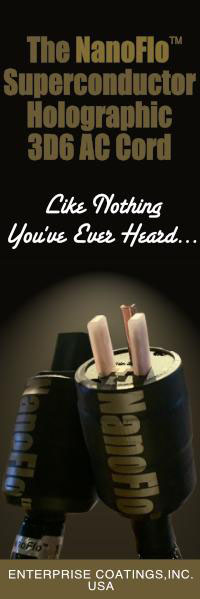

Be the first to comment on: Dayens Ecstasy IV SE Power Amplifier